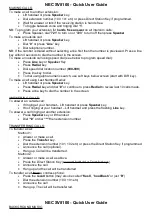
Advanced Operational Features
5-5
41-001390-00 Rev 02 – 12.2011
Configurable DNS Queries
The domain name system (DNS) is the way that Internet domain names are located and translated into Internet Protocol
addresses. A domain name is a meaningful and easy
to remember identifier for an Internet address.
The lists of domain names and IP addresses are distributed throughout the Internet in a hierarchy of authority within a
database of records. There is usually a DNS server within close proximity to your geographic location that maps the
domain names in your Internet requests or forwards them to other servers in the Internet.
The BluStar 8000i may be configured to issue requests for DNS records using one of three methods. In the first method,
the BluStar 8000i issues requests for “
A
” records from the DNS server. In the second method, the BluStar 8000i issues
requests for “
SRV
” records from the DNS server. In the third method, the BluStar 8000i issues requests for
NAPTR
records
from the DNS server. However, the BluStar 8000i does not use the
NAPTR
record to determine whether to use a secure or
unsecure communication path (see the following table for a description of each method).
When the BluStar 8000i accesses the IP network, it issues a DNS lookup request to find the IP address and port and then
waits for a response from the DNS service that provides the IP address and port.
You can configure the BluStar 8000i to use any one of these methods by entering the applicable value in the configura-
tion files:
Note:
Whether or not the BluStar 8000i will operate/communicate in a secure or unsecure mode is ONLY determined by the
pre-provisioning of the BluStar 8000i (i.e. the .cfg file).
Configuration File
Value
DNS Server Method Used
Description
0
A only
The BluStar 8000i issues requests for “
A
” (Host IP Address) records from the DNS server to
get the IP address, and uses the default port number of 5060.
1
SRV & A
The BluStar 8000i issues requests for “
SRV
” (Service Location Record) records from the
DNS server to get the port number. Most often, the IP address is included in the response
from the DNS server to avoid extra queries. If there is no IP address returned in the
response, the BluStar 8000i sends out the request for “
A
” records from the DNS server to
find the IP address.
2
NAPTR & SRV &
First, the BluStar 8000i sends "
NAPTR
" (Naming Authority Pointer) lookup to get the “
SRV
”
pointer and service type. For example, if Global SIP transport protocol on the BluStar 8000i
is “UDP”, and Proxy server on the BluStar 8000i is “test.aastra.com”, then:
1. If the
NAPTR
record is returned empty, the BluStar 8000i will use the default value
“_sip._udp.test.aastra.com" for the “SRV” lookup.
2. If the
NAPTR
record is returned "test.aastra.com SIP+D2U ...._sip._udp.abc.aastra.com",
the BluStar 8000i will use “_sip._udp.abc.aastra.com" for the “
SRV
” lookup.
3. If the
NAPTR
record is returned "test.aastra.com SIP+D2T ...._sip._tcp.test.aastra.com",
where the service type TCP mismatches the phone configured transport protocol “UDP”,
the BluStar 8000i will ignore this value and use the default value “_sip._udp.test.aas-
tra.com" for the “
SRV
” lookup.
Note:
The BluStar 8000i does not use the service type sent by the
NAPTR
response to switch its
transport protocol, nor does it use the
NAPTR
response to determine whether to use a
secure or unsecure communication path. The BluStar 8000i will always use a global sip
protocol that is configured on the BluStar 8000i via configuration files.
After performing
NAPTR
, the
phone
sends “
SRV
” lookup to get the IP address and port
number. If there is no IP address in the “
SRV
” response, then it sends out
an “
A
” lookup to
get it.
Note:
On the phone side, if you configure the phone with a Fully- Qualified Domain Name (FQDN) proxy and specified port,
the phone always sends “
A only
” lookups to find the Host IP Address of the proxy.
















































